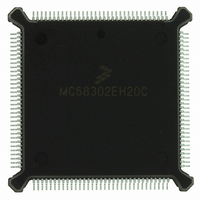MC68302EH20C Freescale Semiconductor, MC68302EH20C Datasheet - Page 254

MC68302EH20C
Manufacturer Part Number
MC68302EH20C
Description
IC MPU MULTI-PROTOCOL 132-PQFP
Manufacturer
Freescale Semiconductor
Datasheets
1.MC68302AG20C.pdf
(4 pages)
2.MC68302AG20C.pdf
(2 pages)
3.MC68302AG20C.pdf
(13 pages)
4.MC68302EH20C.pdf
(481 pages)
Specifications of MC68302EH20C
Processor Type
M683xx 32-Bit
Speed
20MHz
Voltage
5V
Mounting Type
Surface Mount
Package / Case
132-MQFP, 132-PQFP
Family Name
M68000
Device Core
ColdFire
Device Core Size
32b
Frequency (max)
20MHz
Instruction Set Architecture
RISC
Supply Voltage 1 (typ)
5V
Operating Temp Range
0C to 70C
Operating Temperature Classification
Commercial
Mounting
Surface Mount
Pin Count
132
Package Type
PQFP
Lead Free Status / RoHS Status
Lead free / RoHS Compliant
Features
-
Lead Free Status / Rohs Status
Compliant
Available stocks
Company
Part Number
Manufacturer
Quantity
Price
Company:
Part Number:
MC68302EH20C
Manufacturer:
Freescale Semiconductor
Quantity:
10 000
Part Number:
MC68302EH20C
Manufacturer:
FREESCALE
Quantity:
20 000
Company:
Part Number:
MC68302EH20CB1
Manufacturer:
Freescale Semiconductor
Quantity:
10 000
Company:
Part Number:
MC68302EH20CR2
Manufacturer:
Freescale Semiconductor
Quantity:
10 000
- MC68302AG20C PDF datasheet
- MC68302AG20C PDF datasheet #2
- MC68302AG20C PDF datasheet #3
- MC68302EH20C PDF datasheet #4
- Current page: 254 of 481
- Download datasheet (2Mb)
Communications Processor (CP)
TX—Tx Buffer
RX—Rx Buffer
4.5.16.11 Transparent Mask Register
The SCC mask register (SCCM) is referred to as the transparent mask register when the
SCC is operating as a transparent controller. It is an 8-bit read-write register that has the
same bit format as the transparent event register. If a bit in the transparent mask register is
a one, the corresponding interrupt in the event register will be enabled. If the bit is zero, the
corresponding interrupt in the event register will be masked. This register is cleared at reset.
4.6 SERIAL COMMUNICATION PORT (SCP)
The SCP (see Figure 4-44) is a full-duplex, synchronous, character-oriented channel that
provides a three-wire interface (receive, transmit, and clock). The SCP consists of indepen-
dent transmitter and receiver sections and a common clock generator. The transmitter and
receiver sections use the same clock, which is derived from the main clock by a separate
on-chip baud rate generator. Since the MC68302 is an SCP master for this serial channel,
it generates both the enable and the clock signals.
The SCP allows the MC68302 to exchange status and control information with a variety of
serial devices, using a subset of the Motorola serial peripheral interface (SPI). The SCP is
compatible with SPI slave devices. These devices include industry-standard CODECs as
well as other microcontrollers and peripherals.
The SCP enable signals, which can be implemented using the general-purpose I/O pins, are
used to enable one of several potential SCP slave devices. The clock signal (SPCLK) shifts
the received data (SPRXD) in and shifts the transmitted data (SPTXD) out. The clock is gat-
ed; it operates only while data is being transferred and is idle otherwise.
Two successive byte transmissions over the SCP cannot occur immediately back-to-back.
A minimum delay of two to eight bit times is imposed by the SCP, depending on the SCP
clock rate (Communication processor priorities and software handling of interrupts may con-
tribute extra delays). Higher SCP clock rates give higher minimum delay.
4-134
A buffer has been transmitted. If the L bit in the Tx BD is set, TX is set no sooner than on
the second-to-last bit of the last byte being transmitted on the TXD pin. If the L bit in the
Tx BD is cleared, TX is set after the last byte was written to the transmit FIFO.
A complete buffer has been received on the transparent channel. RX is set no sooner than
10 serial clocks after the last bit of the last byte in the buffer is received on the RXD pin.
MC68302 USER’S MANUAL
MOTOROLA
Related parts for MC68302EH20C
Image
Part Number
Description
Manufacturer
Datasheet
Request
R
Part Number:
Description:
Manufacturer:
Freescale Semiconductor, Inc
Datasheet:

Part Number:
Description:
MC68302 Configuring the Chip Selects on the MC68302
Manufacturer:
Motorola / Freescale Semiconductor

Part Number:
Description:
MC68302 Design Concept - Expanding Interrupts on the MC68302
Manufacturer:
Motorola / Freescale Semiconductor

Part Number:
Description:
MC68302 MC68302 Adapting a WAN Controller to a LAN Environment
Manufacturer:
Motorola / Freescale Semiconductor

Part Number:
Description:
MC68302 EKB Applications - Power Measurements on the MC68302
Manufacturer:
Motorola / Freescale Semiconductor

Part Number:
Description:
MC68302 Interfacing the MC68020 to a Slave MC68302
Manufacturer:
Motorola / Freescale Semiconductor

Part Number:
Description:
MC68302 MC68302 Software Performance
Manufacturer:
Motorola / Freescale Semiconductor

Part Number:
Description:
MC68302 Evaluating EDX on the ADS302
Manufacturer:
Motorola / Freescale Semiconductor

Part Number:
Description:
MC68302 Design Advisory #1 - MC68SC302 Passive ISDN Protocol Engine
Manufacturer:
Motorola / Freescale Semiconductor

Part Number:
Description:
MC68302, MC68360, and MPC860 Characteristics and Design Notes for Crystal Feedback Oscillators
Manufacturer:
Motorola / Freescale Semiconductor
Part Number:
Description:
Mc68302 Integrated Multi-protocol Processor
Manufacturer:
Freescale Semiconductor, Inc
Datasheet:
Part Number:
Description:
Manufacturer:
Freescale Semiconductor, Inc
Datasheet:
Part Number:
Description:
Manufacturer:
Freescale Semiconductor, Inc
Datasheet:
Part Number:
Description:
Manufacturer:
Freescale Semiconductor, Inc
Datasheet:
Part Number:
Description:
Manufacturer:
Freescale Semiconductor, Inc
Datasheet:











